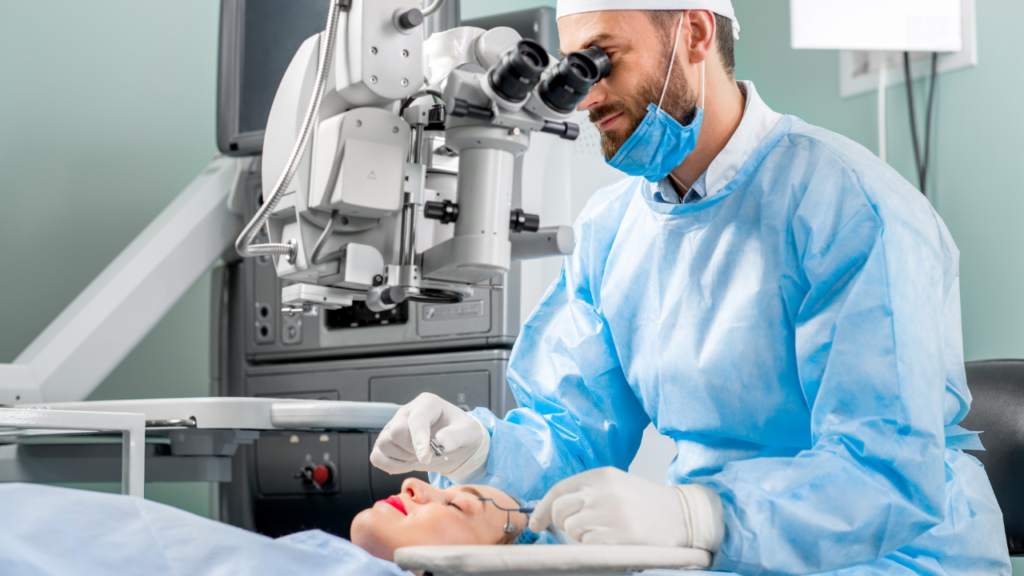Table of Contents
Exercise Daily – Do you notice one eye bigger than the other? If so, then it is possible that you may have Asymmetrical Eyes. Let’s discuss it in detail.
A lot of people ask that they have one eye bigger than the other eye. The most common cause of different eye sizes is Asymmetrical Eyes. Yes, you can definitely blame genetics here because it is a genetic disorder that causes one eye bigger than the other eye.
Having asymmetrical eyes is totally natural and rarely a reason for concern, according to experts. It is fairly normal to have asymmetrical face traits, and having entirely symmetrical facial features is not the norm.
While uneven eyes may be observable to you, it is unlikely that others would notice them as well.
Skin changes that occur as a normal part of the aging process may cause the appearance of uneven eyes. It is possible that a medical problem may be the cause of asymmetrical eyes in some cases.
Causes of One Eye Bigger Than The Other

Asymmetrical eyes are frequently caused by genetic factors. You’re likely to have face characteristics that are comparable to those of your parents and other family members, just as you are with your other facial characteristics.
Chances are you’ll notice that others in your family have one eye that seems to be higher than the other if you pay close attention.
Other probable causes of uneven eyes, as well as their associated symptoms, are listed below.
Enophthalmos
Enophthalmos, also known as posterior displacement of the eye, occurs when the space behind the eye is altered by an accident or medical condition, causing the eye to sink into the socket. It might happen all at once or gradually over a period of years.
Trauma is the most prevalent cause of enophthalmos, and it can occur as a result of being struck in the face or hurting your face while driving a car. Additionally, it can be brought on by a variety of medical problems, particularly those that affect the sinus cavity behind the eyes.
Some people have no symptoms at all, except the look of one eye sinking or drooping. You may also have a tugging feeling beneath the eye, nasal difficulties, or face pain, depending on the underlying problem. So, enophthalmos can be a cause of one eye bigger than the other.
Aging
According to imaging studies, there is a considerable correlation between growing older and facial asymmetry.
As people get older, the soft tissues in their faces begin to loosen. Bones do not develop in the same way that cartilage does, such as cartilage in the nasal passage. Asymmetry may result as a result of these modifications.
Ptosis
Droopy eyelids, also known as droopy eyelid syndrome, can be present at birth (congenital) or develop later in life. Ptosis is more frequent in elderly persons than in younger adults.
In this case, the levator muscle, which is responsible for holding up your eyelid, strains or detaches from the eyelid, resulting in the lid drooping. When this happens, it gives the illusion of asymmetrical eyes, with one eye seeming lower than the other.
Ptosis can damage one or both eyes in certain persons. Ptosis is most commonly induced by the aging process, although it can also be caused by neurological diseases, tumors, and brain injury.
If your eyelid droops to the point that it is interfering with your vision, surgery may be necessary to repair it. If you so want, surgery might also be performed just for cosmetic purposes.
Lifestyle Factors
Some aspects of one’s lifestyle might play a role in the development of uneven eyes. In one study, researchers discovered a correlation between smoking and upper eyelid ptosis, often known as drooping eyelids, in a set of twins.
Aside from that, prolonged exposure to the sun might cause changes in the skin around the eyes. Sun damage may be more severe on one side of the face than on the other, resulting in facial asymmetry.
So, lifestyle factors may also cause one eye bigger than the other.
Bulging eye
A bulging eye and a tiny eye might go hand in hand. In people with Graves disease, which causes swelling of the tissue around and behind the eyeball, forcing the eyeball forward, this is a regular occurrence, especially in the morning.
It is possible that your other eye will look smaller as a result. Other signs and symptoms to watch for include a decline in your ability to see, double vision, redness or discomfort in your eyes, a headache, pulsation of the bulging eye, and a temperature.
Treatment for this ailment is dependent on the exact reason; however, in certain circumstances, artificial tears can be beneficial in reducing the severity of the problem. Occasionally, antibiotics are used as a kind of therapy in addition to other methods.
Treatments for One Eye Bigger Than The Other

In most cases, there is no need for treatment for uneven eyes. When it comes to treatment, it is entirely up to the individual, barring an underlying medical issue that necessitates intervention or asymmetry that is interfering with your eyesight.
Cosmetic treatments and surgical procedures, as well as at-home makeup techniques, can be used to make your eyes look more symmetrical. These procedures range from surgical to non-surgical cosmetic operations.
Don’t Do Anything
If asymmetrical eyes are not the result of a medical disease or are not causing vision impairment, there is no reason to seek treatment. In this instance, the therapy is for cosmetic reasons and is based on the patient’s own preference.
Makeup
Makeup may be able to help you achieve a more symmetrical appearance with your eyes. Contouring, highlighting, and other methods can be used to draw attention to certain aspects while maintaining a sense of balance.
Evening out the look of your brows with an eyebrow pencil or powder will assist to make your eyes appear more even in appearance.
This may be accomplished with the assistance of internet video lessons. Cosmetic and department stores with makeup artists and cosmeticians on staff who can demonstrate how to apply goods to improve your characteristics are abundant on the market nowadays.
Makeup is an excellent way to treat one eye bigger than the other in the short run.
Brow Lift
A brow lift, also known as forehead rejuvenation or a forehead lift, is a cosmetic operation that is used to elevate the brows of the patient.
It is carried out by a cosmetic surgeon when the patient is under general anesthesia. Different surgical procedures can be employed in the performance of an eyebrow lift, including the following:
- coronal brow lift
- endoscopic brow lift
- hairline brow lift
Any surgical operation has the danger of infection, bleeding, and scars. These risks are the same as they are for any other surgery.
Botox
Botox can be used as a temporary treatment for uneven eyes in some situations. Most of the time, it is a person’s brows that are asymmetrical, which makes the eyes look uneven.
Asymmetry between the brows is common. Botox is a non-surgical alternative to a brow lift that is becoming increasingly popular.
It is possible to inject Botox, a muscle relaxant that is injectable, into the region around the brow so that it becomes relaxed, which can assist to create a more balanced appearance. It is typical for the effects to persist for four months or longer.
Blepharoplasty
Blepharoplasty is a cosmetic surgical procedure that is done to fix sagging or uneven eyelids. It is also effective to treat one eye bigger than the other.
Although the process does not make your eyes symmetrical, it can make them look symmetrical even if you have extra fat or skin around your eyes that make them appear asymmetrical.
Excess tissue, such as fat, muscle, and skin, is removed from either the upper or lower eyelids during the treatment, depending on your preference.
Bruising and swelling are frequent, and they endure for around two weeks on average. It might take several months for incision scars to vanish completely.
Orbital Surgery
You might think of orbital surgery as surgery on your eye socket. In addition to four bone walls, the orbit also contains the orbital bone, the eyeball, eye muscles, the optic nerve, and fat.
In order to address injuries and medical disorders affecting this area, a variety of surgical techniques are available.
This can involve surgery to mend fractures or remove tumors, or orbital decompression surgery, which is used to cure exophthalmos caused by Graves disease and infections.
Eyelid Tape
Consider eyelid tape to be similar to one-day contact lenses. The fact that they are virtually undetectable means that you can comfortably wear them all day.
You’ll notice a noticeable improvement immediately after putting them on. It is a temporary method to treat one eye bigger than the other.
Eyelid tape works by raising the skin that has sagged across the upper eyelid. Lifting one or both of your eyes can help you seem more symmetrical and youthful by making them appear more symmetrical and younger.
It is significantly more cost-effective and safe than surgery in the short term. It also provides you with all of the same advantages. If the eyelid tape is well-made, it should be both attractive and pleasant to wear for extended periods of time.
FAQs – One Eye Bigger Than The Other
Is it normal to have asymmetrical eyes?
It is quite normal to have asymmetrical eyes, and it is rarely a source of worry. Facial asymmetry is quite prevalent, and having fully symmetrical facial characteristics is not the norm. While uneven eyes may be noticeable to you, it is unlikely that others would notice them as well.
What causes eyes to become uneven?
The majority of people are not born with perfectly symmetrical facial features. Uneven eyes are caused by genetics, which is a natural occurrence.
A person’s nose shape, as well as genetically uneven eyebrows, may also contribute to the impression of asymmetrical eyes. Eyes that are genetically uneven are not a reason for worry.
Are asymmetrical eyes attractive?
According to one study conducted in 1996, among children and young people who made expressive faces (as most children and young adults do), those with slight facial asymmetry were judged more beautiful than those with no facial asymmetry.
What are uneven eyes called?
Asymmetrical eyes, or eyes that are not the same size, shape, or level as each other, can be present in a large percentage of the population. In rare instances, having asymmetrical eyes may suggest the presence of a medical issue that requires treatment.
How can I naturally fix my asymmetrical face?
Facial yoga moves not only to improve circulation but also to engage the muscles that assist to tighten the skin. It can help to treat one eye bigger than the other.
This prevents the development of jowls and drooping skin that develop over time as a result of the natural effects of gravity, as well as the atrophying of the face muscles. Try some of the face yoga moves listed below to see if they work for you.
- Make a puffing motion with your cheeks, then pump air into your mouth and shift it from one side to the other four times. Repeat as many times as necessary throughout the day to help lift the cheeks.
- Widen your eyes and enhance your brows while sticking out your tongue as well. Hold for up to 60 seconds and repeat as many times as you want. This is beneficial for the neck and cheeks.
- Make a tight O with your lips by pinching them together. Then, without allowing the mouth to move, grin and squint your eyes while keeping your mouth closed. Repeat this procedure ten times to help tighten the skin overall.
- Clasp your hands together in front of your face and grin widely. Make sure the entire hands block the mouth from genuinely smiling by placing them over the lips. Essentially, the goal is for the face muscles to act in opposition to the hands. To help tighten the face muscles, repeat the exercise ten times.
Conclusion
So, now you know why one eye bigger than the other. Uneven eyes are generally normal and are only seldom a cause for worry in a medical setting. We are the ones who are most critical of ourselves, yet it is likely that no one else has noticed the imbalance in our judgment.
You should consult with your doctor if you have any concerns about what is causing your asymmetry or if you are having any other symptoms.








